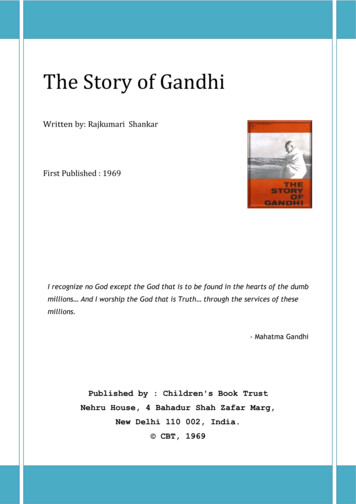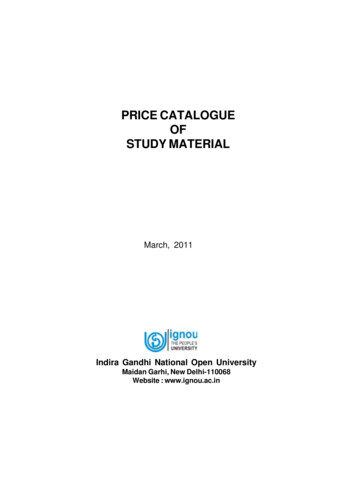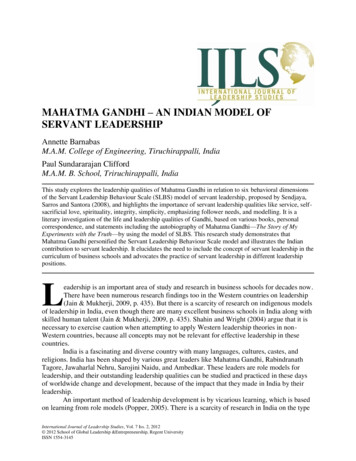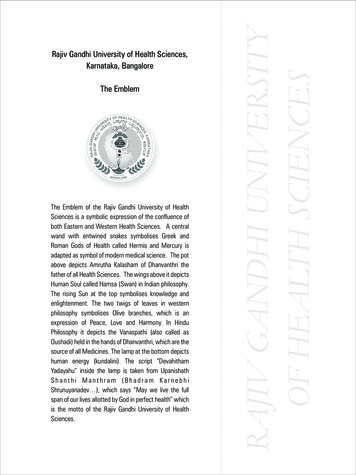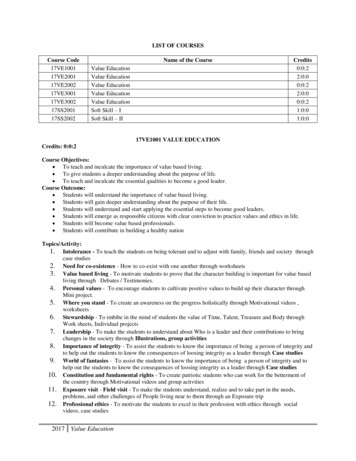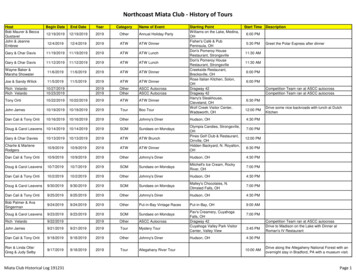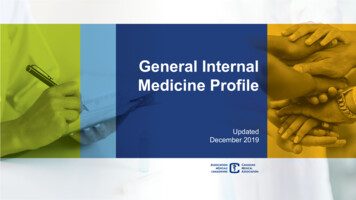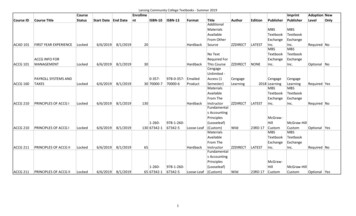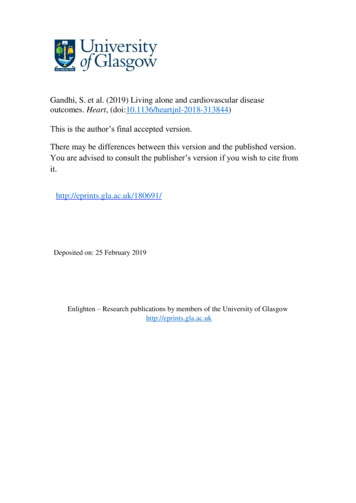
Transcription
Gandhi, S. et al. (2019) Living alone and cardiovascular diseaseoutcomes. Heart, (doi:10.1136/heartjnl-2018-313844)This is the author’s final accepted version.There may be differences between this version and the published version.You are advised to consult the publisher’s version if you wish to cite fromit.http://eprints.gla.ac.uk/180691/Deposited on: 25 February 2019Enlighten – Research publications by members of the University of Glasgowhttp://eprints.gla.ac.uk
Living Alone and Cardiovascular Disease OutcomesSumeet Gandhi, MD1, Shaun G. Goodman, MD, MSc1, Nicola Greenlaw, MSc2,Ian Ford, PhD2, Paula McSkimming, BSc2, Roberto Ferrari, MD3, Yangsoo Jang,MD4, Marco Antonio Alcocer-Gamba, MD5, Kim M. Fox, MD6, Jean-ClaudeTardif, MD7, Michal Tendera, MD8, Paul Dorian, MD1, Philippe Gabriel Steg, MD6and 9, Jacob A. Udell, MD, MPH10Author Affiliations: 1Terrence Donnelly Heart Centre, St Michael’s Hospital, University ofToronto, Toronto, Canada; 2Robertson Centre for Biostatistics, University of Glasgow, Glasgow,United Kingdom; 3Department of Cardiology and LTTA Centre, University Hospital of Ferrara andMaria Cecilia Hospital, Cotignola, Italy; 4Yonsei University College of Medicine, SeveranceCardiovascular Hospital, Seoul, Korea; 5Universidad Autónoma de Querétaro, Jefe deCardiología Intervencionista, Instituto de Corazón de Querétaro, Querétaro, Mexico; 6NationalHeart and Lung Institute, Imperial College, Institute of Cardiovascular Medicine and Science,Royal Brompton Hospital, London, United Kingdom; 7Montreal Heart Institute, Université deMontréal, Montreal, Canada; 8Medical University of Silesia, School of Medicine in Katowice,Poland; 9French Alliance for Cardiovascular Trials, an F-CRIN network, Université Paris-Diderot,AP-HP and INSERM U1148, Paris, France; 10Peter Munk Cardiac Centre and Women's CollegeHospital, University of Toronto, Toronto, CanadaCorresponding author: Jacob A Udell, Women's College Hospital / Peter MunkCardiac Centre / Toronto General Hospital / University of Toronto, 76 GrenvilleStreet, Toronto, Ontario M5S 1B1. Telephone: 416-351-3732 x2459, Fax: 416351-3746, Email: jay.udell@utoronto.caShort Title: Living alone and CADManuscript Word Count (including tables, references, figure legend): 6, 130Abstract Word Count: 243The Corresponding Author has the right to grant on behalf of all authors anddoes grant on behalf of all authors, a worldwide license to the Publishers and itslicensees in perpetuity, in all forms, formats and media (whether known now orcreated in the future), to i) publish, reproduce, distribute, display and store theContribution, ii) translate the Contribution into other languages, createadaptations, reprints, include within collections and create summaries, extractsand/or, abstracts of the Contribution, iii) create any other derivative work(s)based on the Contribution, iv) to exploit all subsidiary rights in the Contribution, v)the inclusion of electronic links from the Contribution to third party materialwhere—ever it may be located; and, vi) license any third party to do any or all ofthe above. The Corresponding Author has the right to grant on behalf of allauthors and does grant on behalf of all authors, an exclusive licence (or nonexclusive for government employees) on a worldwide basis to the BMJPublishing Group Ltd and its Licensees to permit this article (if accepted) to bepublished in HEART editions and any other BMJPGL products to exploit allsubsidiary rights.1
SOURCES OF FUNDINGRole of the funding source: The CLARIFY registry is supported by Servier. Thesponsor had no role in the study design or data analysis and interpretation; or inthe decision to submit the manuscript for publication. The sponsor assisted withthe set-up, data collection, and management of the study in each country. Thecorresponding author had full access to all the data in the study and had finalresponsibility for the decision to submit for publicationAuthor Contributions: IF had full access to all the data in the study and takesresponsibility for the integrity of the data and the accuracy of the data analysis.SG wrote the first draft of the manuscript. Study conception or design: SG, SGG,PGS and JAU. Acquisition, analysis, or interpretation of data: All authors. Criticalrevision of the manuscript for important intellectual content: All authors. Statisticalanalysis: IF, NG and PMS. Administrative, technical, and material support: SGG,NG, and PGS. Study supervision: SGG, PGS. All authors have approved the finalarticle.Transparency statement: The lead author affirms that this manuscript is anhonest, accurate, and transparent account of the study being reported; that noimportant aspects of the study have been omitted; and that any discrepanciesfrom the study as planned (and, if relevant, registered) have been explained.2
DISCLOSURESAll authors have completed the ICMJE uniform disclosure form at www.icmje.org/coi disclosure.pdf and declare:SG reports no relationships to discloseJAU reported consultancy fees from consulting: Johnson & Johnson, Merck,Novartis, Sanofi Pasteur; Novartis (steering committee).PD reports grants and personal fees from Servier, outside the submitted work.SGG reports grants from Servier during the conduct of the study; personal feesfrom Servier Canada, outside the submitted work.RF reports honorarium from Servier for steering committee membership,consulting, speaker’s bureau fees and support for travel to study meetings;personal fees from Boehringer-Ingelheim, Novartis, Merck Serono and Irbtech;he is a stockholder in Medical Trials Analysis.IF reports grants and personal fees from Servier during the conduct of the study;grants and personal fees from Amgen, outside the submitted work.KMF reports personal fees and non-financial support from Servier during theconduct of the study, from Broadview Ventures; personal fees from AstraZeneca,TaurX, CelAegis, outside the submitted work; non-financial support from Armgo,Director of Vesalius Trials LtdDinimal and stockholder of Armgo and CellAegis.MAAG reports no relationships to disclose.NG reports grants from Servier during the conduct of the study.PMS reports grants from Servier during the conduct of the study.3
PGS reports grants from Merck, Sanofi, Servier; personal fees from Amarin,Amgen, AstraZeneca, Bayer, Boehriner-Ingelheim, BristolMyersSquibb, CSLBehring, Daiichi-Sankyo, Janssen, Lilly, Merck, Novartis, Pfizer, Regeneron,Sanofi, Servier, The Medicines Company, outside the submitted work .JCT reports personal fees from Servier, during the conduct of the study; grantsfrom Amarin, Astra-Zeneca, DalCor, Eli Lilly , Esperion, Ionis , Merck , Pfizer ,Sanofi , Servier; personal fees from DalCor, Pfizer, Sanofi, Servier, holds minorequity interest in DalCor, outside the submitted work; a patentPharmacogenomics-Guided Therapy with CETP Inhibitor pending.MT reports personal fees from Servier during the conduct of the study; personalfees from Bayer, Celyad, KOWA, Janssen-Cilag, PERFUSE Study Group; grantsfrom Polish National Center for Research and Development, outside thesubmitted workYJ reports no relationships to disclose.4
STRUCTURED ABSTRACTObjective: To evaluate cardiovascular (CV) outcomes in outpatients withcoronary artery disease (CAD) living alone compared to those living with others.Methods: The prospeCtive observational LongitudinAl RegIstry oF patients withstable coronarY artery disease (CLARIFY) included outpatients with stable CAD.CLARIFY enrolled participants in 45 countries from November 2009 to July 2010,with 5 years of follow-up. Living arrangement was documented at baseline. Theprimary outcome was a composite of major adverse cardiovascular events(MACE) defined as CV death, myocardial infarction (MI), and stroke.Results: Among 32,367 patients, 3,648 patients were living alone (11.3%). Aftermultivariate adjustment, there were no residual differences in MACE amongpatients living alone compared to those living with others (HR 1.04, 95% CI 0.921.18, p 0.52), however there was significant heterogeneity in the exposure effectby sex (Pinteraction 0.01). Specifically, men living alone were at higher risk forMACE (HR 1.17, 95% CI 1.002-1.36, p 0.047) as opposed to women living alone(HR 0.82, 95% CI 0.65-1.04, p 0.1), predominantly driven by a heterogeneouseffect by sex on MI (Pinteraction 0.006). There was no effect modification for MACEby age group (Pinteraction 0.3) although potential varying effects by age for MI(Pinteraction 0.046) and stroke (Pinteraction 0.05).Conclusions: Living alone was not associated with an independent increase inMACE, although significant sex-based differences were apparent. Men livingalone may have a worse prognosis from CV disease than women, furtheranalyses are needed to elucidate the mechanisms underlying this difference.5
Trial registration: CLARIFY is registered in the ISRCTN registry of clinical trials(ISRCTN43070564).Keywords: social isolation, living alone, coronary artery disease, cardiovasculardiseaseAbbreviations list: chronic obstructive pulmonary disease (COPD), congestiveheart failure (CHF), coronary artery disease (CAD); coronary artery bypass graft(CABG), cardiovascular disease (CVD), electrocardiogram (ECG), majorcardiovascular events (MACE), myocardial infarction (MI), percutaneouscoronary intervention (PCI)6
Key questions:What is already known about this subject?Patients living alone with coronary artery disease (CAD) may be at increased riskfor cardiovascular (CV) events. As individuals with stable CAD live longer withadvanced comorbidities, there is an important public health implication todetermine if living status is independently associated with poor health outcomes.What does this study add?The CLARIFY registry included outpatients with CAD with 5 years of follow-up.Our study suggests that living alone in patients with stable CAD was notassociated with an independent increase in major adverse cardiovascular events(MACE), although age and sex-based differences were apparent.How might this impact on clinical practice?Elderly patients and women living alone may have potentially lower CV risk,which warrants further confirmation.7
Key Message: The CLARIFY registry included outpatients with CAD with 5 years of followup. After multivariate adjustment, there were no differences in MACE amongpatients living alone compared to those living with others, however there wassignificant heterogeneity in the exposure effect by sex. Men living alone were at higher risk for MACE as opposed to women livingalone, driven by a heterogeneous effect by sex on MI (Pinteraction 0.006). There was no effect modification for MACE by age group (Pinteraction 0.3)although potential varying effects by age for MI (Pinteraction 0.046) and stroke(Pinteraction 0.05). Future large studies in patients with established CAD will evaluate patientsocial isolation using validated tools/scoring system, which will inform healthcare practitioners of patients with potential increased long-term CV risk, aswell assist in forming beneficial psychosocial interventions.8
INTRODUCTIONSocial isolation refers to the lack of contact an individual has with society, withliving alone frequently used as a surrogate.(1) Living alone may lead to pooroutcomes in patients with coronary artery disease (CAD) through a complexinteraction between increased neurohormonal stress with acceleratedatherosclerosis, less adherence to guideline recommended therapy andsecondary prevention targets, increased anxiety and depression leading to morepsychological distress, poor coping mechanisms/self-care, and less access tohealth care services.(2, 3) Previous analyses have sought to gain insight into therisk of living alone in patients with established cardiovascular disease (CVD). Theeffect of living alone has been variable due to the significant heterogeneityamongst the populations studied, with sub-group analysis showing potentialeffect modification by age and sex, and potential lower risk among women andelderly patients living alone.(4-7)Patients with CAD are diverse with differences in ethnicity, socioeconomicstatus, location, and psychosocial factors which may play a role in the risk ofrecurrent CV events.(8) The prospeCtive observational LongitudinAl RegIstry oFpatients with stable coronarY artery disease (CLARIFY) was initiated to improveknowledge about patients with stable CAD from a broad geographicperspective.(9) As individuals with stable CAD live longer with advancedcomorbidities, there is an important public health implication to determine if livingstatus is independently associated with poor health outcomes. The objective ofthis analysis was to determine, in a stable CAD population, if living alone is9
associated with increased CV risk. Given previous research, effect modificationby sex and age group were further explored in this post-hoc analysis.METHODSSTUDY DESIGN AND PATIENT SELECTIONThe CLARIFY study cohort included outpatients with stable CAD with 5 years offollow-up, the study methods and design were previously published.(9-12)Patients eligible for enrolment were those with stable CAD diagnosed by at leastone of the following: 1) documented myocardial infarction (MI) ( 3 months ago);2) coronary stenosis 50% on coronary angiography; 3) chest pain withmyocardial ischemia determined by stress electrocardiogram (ECG), stressechocardiography, or myocardial imaging; or 4) history of revascularization bycoronary artery bypass graft (CABG) surgery or percutaneous coronaryintervention (PCI) (performed 3 months ago). Patients hospitalized for CVDwithin the previous 3 months (including for revascularization), patients for whomrevascularization was planned, and patients with conditions expected to hamperparticipation of 5-year follow-up were excluded from participating in the study. Atotal of 32,703 subjects were enrolled in 45 countries, from November 2009 toJuly 2010 (Table S1).DATA COLLECTIONThe investigators completed standardised electronic case report forms atbaseline and yearly at each visit for up to 5 years. Living arrangement status was10
documented as either “living alone” or “not living alone” at baseline. Furtherinformation collected at baseline included demographics; prior medical historyand cardiovascular risk factors; current symptoms; physical examination;laboratory values (e.g., fasting blood glucose, hemoglobin A1c [HbA1c],cholesterol, triglycerides); and current chronic drugs regimen (i.e., those takenregularly by the patient for 7 days before entry in the registry). Data wasrecorded if an ECG was available for whether the patient was in sinus rhythm,atrial fibrillation/atrial flutter, paced rhythm, or left bundle branch block (LBBB).The remaining patients may not have had ECG data available or may be inanother rhythm then above. Investigators reported number of vessels withdisease and number of coronary territories with significant stenosis ( 50%)independent of whether the patient had a recent angiogram (within 12 months).This data was investigator reported independent of the most recent availableangiogram results and may not be mutually exclusive.For patients missing the yearly in-person visit, telephone contact with thepatient, a designated relative or contact, or their physician was attempted. Toensure data quality, onsite-monitoring visits of 100% of the data in 5% of centreswere selected at random, regular telephone contact with investigators to reducemissing data and loss to follow-up, and centralised verification of the electroniccase report forms for completeness, consistency, and accuracy were undertaken.OUTCOMESAt each annual follow-up visit, clinical outcomes occurring during the previous 1211
months were recorded. The primary outcome of this analysis was major adversecardiovascular events (MACE), which included CV death, nonfatal or fatal MI,and nonfatal or fatal stroke. Secondary outcomes were all-cause death, CVdeath, MI, stroke, unstable angina, and major bleeding (defined as leading tohospitalization or transfusion). CV death was defined as fatal MI or stroke, otherCV death or death due to unknown cause; any MI or stroke followed by death inthe subsequent 28 days was considered fatal. Events were accepted as reportedby patients and physicians, without central adjudication, however all events weresource verified during audits.The study was performed in accordance with the principles of theDeclaration of Helsinki and was approved by the National Research EthicsService, Isle of Wight, Portsmouth and Southeast Hampshire Research EthicsCommittee, UK. Approval was also obtained in all participating countries, inaccordance with local regulations before recruitment of the first participant. Allpatients gave written informed consent to participate, in accordance with nationaland local guidelines. There was no patient/public involvement in this researchstudy. CLARIFY is registered in the ISRCTN registry of clinical trials(ISRCTN43070564).STATISTICAL ANALYSISAll CLARIFY data were collected and analyzed at an independent academicstatistics center at the Robertson Centre for Biostatistics, University of Glasgow,UK, which was responsible for managing the database, performing all analyses12
and data storage. Baseline variables are summarized as means and standarddeviations (SDs) or medians and interquartile ranges (IQRs) for continuous data,depending on the distribution of the data; and as counts and percentages forcategorical data. In this post-hoc analysis, differences between patients livingalone and those living with others were compared using Chi-squared tests orFisher’s exact test for categorical variables as appropriate, and 2 sample t-testsor Wilcoxon Mann-Whitney tests for continuous variables, depending on thedistribution of the data. A Cox proportional hazards model was used to assessthe risk associated with living alone and time to first cardiovascular outcomes.Crude and multivariable adjusted hazards ratios (HRs) and corresponding 95%confidence intervals (CIs) were estimated after adjustment for age, sex, andgeographic region; as well as baseline history of smoking, diabetes, peripheralarterial disease, MI, PCI, CABG, asthma/chronic obstructive pulmonary disease(COPD), and congestive heart failure (CHF). Additional clinical characteristicswere also adjusted for, including baseline systolic blood pressure, diastolic bloodpressure, left ventricular ejection fraction, and number of vessels with coronaryartery stenoses. Heterogeneity was assessed with interaction testing betweenliving status and sex, age group ( 65 years, 65–74 years, 75 years), and historyof prior MI at baseline for primary and secondary endpoints after multivariableadjustment. All p-values for the Cox proportional hazards models were obtainedusing the Wald test.13
RESULTSA total of 32,367 patients were eligible for inclusion in the analysis with 3,648patients documented as living alone (11.3%) and 28,728 (88.8%) patients livingwith others. Table 1 and Table 2 includes baseline characteristics, studyinclusion, previous medical history, CV risk factors, and symptom profile. Themean age for patients living alone was 67 ( 10.66) years. Patients living alonewere older, more likely to be female, predominantly white, less likely to beemployed full time, and more likely to be retired than those living with others.More patients living alone were current smokers, had a history of atrial fibrillation,prior HF hospitalisation, history of peripheral arterial disease, and yet had lessdiabetes. Table 3 describes cardiovascular therapies. There was a high use ofguideline recommended pharmacologic therapy in both groups, there was alower number of patients living alone taking thienopyridines, beta-blockers, andstatins.Table 1. Baseline Characteristics by Living Arrangement StatusLiving alone (n 3648)Age (years), mean (SD)Males (%)Body Mass Index (kg),median (25th, 75thquartiles),Waist Circumference(cm), median (25th, 75thquartiles)Ethnicity (%)WhiteSouth AsianChinesep-value67.2 (10.7)2254 (61.8)27 [25, 31]Not living alone(n 28,728)63.8 (10.4)22857 (79.6)27 [25, 30]96 [88, 105]97 [89, 105]0.012644 (72.5)130 (3.6)167 (4.6)18304 (63.8)2285 (8.0)2573 (9.0) 0.00114 0.001 0.0010.032
Japanese/KoreanHispanicBlack/AfricanUnknown142 (3.9)110 (3.0)44 (1.2)411 (11.3)893 (3.1)1458 (5.1)294 (1.0)2921 (10.2)Employment status(%)Employed full-timeEmployed part-timeUnable to workUnemployedRetiredOther605 (16.6)227 (6.2)146 (4.0)143 (3.9)2415 (66.2)112 (3.1)7291 (25.4)2022 (7.0)1119 (3.9)1689 (5.9)15505 (54.0)1101 (3.8) 0.0011011 (27.7)7561 (26.3) 0.0011785 (49.0)852 (23.4)13251 (46.1)7913 (27.6)2150 (59.0)2051 (56.2)907 (24.9)218 (6.0)65 (1.8)17251 (60.0)16906 (58.9)6722 (23.4)1294 (4.5)342 (1.2)0.200.0030.049 0.0010.003124 (3.4)70 (1.9)653 (2.3)424 (1.5) 0.0010.040350 (9.6)425 (11.7)2107 (7.3)2777 (9.7) 0.001 0.001137 (3.8)856 (3.0)0.010166 (4.6)324 (8.9)1120 (30.7)1135 (4.0)1960 (6.8)8096 (28.2)0.082 0.0010.0012638 (72.3)977 (26.8)2773 (76.0)363 (10.0)20351 (70.9)8415 (29.3)21485 (74.8)2031 (7.1)0.0660.0020.109 0.001Education level (%)Primary school (orless)Secondary schoolCollege/UniversityMedical History (%)Myocardial InfarctionPCICABGHospitalization for CHFInternal CardiacDefibrillatorPacemakerAortic abdominalaneurysmCarotid DiseasePeripheral ArterialDiseaseTransient IschemicAttackStrokeAtrial Fibrillation/FlutterFamily History ofPremature CADTreated HypertensionDiabetesDyslipidemiaAsthma/COPDSmoking status (%)15
CurrentFormerNever536 (14.7)1505 (41.3)1607 (44.0)3501 (12.2)13468 (46.9)11759 (40.9) 0.001Alcohol intake (numberof drinks per week) (%)0 0 and 2020-40 401741 (47.7)1745 (47.8)144 (4.0)18 (0.5)13684 (47.6)14025 (48.8)921 (3.2)93 (0.3)0.032Stimulant drinksconsumed (%)CoffeeTeaNeither1789 (49.1)1200 (32.9)658 (18.0)13551 (47.2)8781 (30.6)6380 (22.2) 0.0012 [2, 4]2 [2, 4]0.011Daily intake of stimulantdrinks (cups/day),median (25th, 75thquartiles)Physical Activity (%)No physical activity639 (17.5)4584 (16.0)0.023weeklyLight physical activity1850 (50.7)14782 (51.5)most weeksAt least 20 minutes567 (15.6)4860 (16.9)vigorous physicalactivity once or twice aweekAt least 20 minutes591 (16.2)4495 (15.7)vigorous physicalactivity at least threetimes a weekCABG, coronary artery bypass graft surgery; CAD, coronary artery disease;CHF, congestive heart failure; COPD, chronic obstructive pulmonary disease;CCS, Canadian Cardiovascular society; DBP, diastolic blood pressure; ECG,electrocardiogram; HBA1C, hemoglobin A1C, LBBB, left bundle branch block;NYHA, New York Heat Association; PCI, percutaneous coronary intervention;SBP, systolic blood pressure16
Table 2. Baseline Cardiovascular Characteristics by Living ArrangementStatusAny angina (%)Angina and CCS ClassNo AnginaAngina CCS Class IAngina CCS Class IIAngina CCS Class IIIAngina CCS Class IVCHF symptoms includingNYHA classNo CHF (%)CHF NYHA Class IICHF NYHA Class IIIHeart Rate (palpation), meanSBP (mm Hg), meanDBP (mm Hg), meanLeft Ventricular EjectionFraction (%), meanNumber of vessels withdisease (%)*012 or moreCoronary territories withstenosis 50% (%)*Left MainLeft anterior descendingCircumflex arteryRight coronary arteryBypass GraftNo significant stenosisCoronary angiography notperformed (within 12 months)**ECG Rhythm (%)Sinus rhythmLiving alone(n 3648)840 (23.0)Not living alone(n 28,728)6328 (22.0)2807 (77.0)263 (7.2)417 (11.4)150 (4.1)10 (0.3)22399 (78.0)1788 (6.2)3396 (11.8)1075 (3.7)68 (0.2)p-value0.170.130.893098 (84.9)456 (12.5)94 (2.6)24375 (84.9)3642 (12.7)709 (2.5)68.3 (10.6)132.2 (17.2)76.9 (10.1)56.5 (11.3)68.2 (10.6)130.9 (16.6)77.3 (10.0)56.0 (11.0)0.79 0.0010.0200.0320.005139 (4.6)1279 (41.9)1634 (53.5)864 (3.5)10053 (40.9)13649 (55.6)335 (9.2)2075 (56.9)1208 (33.1)1520 (41.7)299 (8.2)146 (4.0)586 (16.1)2500 (8.7)16827 (58.6)10468 (36.5)12590 (43.8)2300 (8.0)906 (3.2)4138 (14.4)2462 (93.1)20499 (95.2)0.330.051 0.0010.0130.690.0070.007 0.00117
Atrial Fibrillation/FlutterPaced rhythmLBBB121 (4.6)62 (2.3)158 (6.0)702 (3.3)332 (1.5)1025 (4.8)0.0063HbA1C (%), mean (SD)6.7 (1.2)6.8 (1.8)0.018Creatinine (mmol/L), median87 [74, 100]88 [76, 102] 0.001(25th, 75th quartiles)Hemoglobin (g/dL), median 0.001thth13.9[12.9,14.9]14.1[13.0,15.0](25 , 75 quartiles)Fasting Blood Glucose5.6 [5.0, 6.5]5.7 [5.1, 6.7] 0.001thth(mmol/L), median (25 , 75quartiles)Total Cholesterol (mmol/L),4.4 [3.7, 5.1]4.3 [3.7, 5.0]0.002median (25th, 75th quartiles)HDL (mmol/L), median (25th,1.2 [1.0, 1.5]1.1 [1.0, 1.4] 0.00175th quartiles)LDL (mmol/L), median (25th,2.37 [1.89, 2.94]2.37 [1.90, 2.94]0.6875th quartiles)Fasting Triglycerides (mmol/L), 1.39 [1.00, 1.88]1.40 [1.02, 1.93]0.15median (25th, 75th quartiles)CABG, coronary artery bypass graft surgery; CAD, coronary artery disease; CHF,congestive heart failure; COPD, chronic obstructive pulmonary disease; CCS,Canadian Cardiovascular society; DBP, diastolic blood pressure; ECG,electrocardiogram; HBA1C, hemoglobin A1C, LBBB, left bundle branch block;NYHA, New York Heat Association; PCI, percutaneous coronary intervention; SBP,systolic blood pressure* Investigators reported number of vessels with disease and number of coronaryterritories with significant stenosis ( 50%) independent of whether the patient hada recent angiogram (within 12 months). This data was investigator reportedindependent of the most recent available angiogram results and may not bemutually exclusive.** Data was recorded if an ECG was available for whether the patient was in sinusrhythm, atrial fibrillation/atrial flutter, paced rhythm, or left bundle branch block(LBBB). The remaining patients may not have had ECG data available or may be inanother rhythm then above.18
Table 3. Medications and Reimbursement Status at Baseline by LivingArrangement StatusLiving aloneNot living alone(N 3648)(N 28728)Medication (%)Aspirin3154 (86.5)25257 (87.9)Thienopyridine835 (22.9)7944 (27.7)Other Antiplatelets291 (8.0)2695 (9.4) 2 antiplatelets3644 (99.9)28721 (99.9)Oral anticoagulants299 (8.2)2331 (8.1)Beta-Blockers2652 (72.7)21718 (75.6)Symptoms indicative of516 (14.2)4167 (14.5)intolerance or contraindicationto Beta-BlockersIvabradine330 (9.1)2873 (10.0)Calcium antagonists1057 (29.0)7765 (27.0)ACE inhibitor or ARB2790 (76.5)21902 (76.2)Lipid-lowering drugs3301 (90.5)26598 (92.6)Statins2954 (81.0)23886 (83.2)Long-acting nitrates764 (21.0)6313 (22.0)Other antianginal agents491 (13.5)4030 (14.0)Diuretics3154 (86.5)25257 (88.0)Other antihypertensive agents283 (7.8)1946 (6.8)Digoxin and derivatives108 (3.0)706 (2.5)Amiodarone/Dronedarone111 (3.0)835 (2.9)Other antiarrhythmics46 (1.3)260 (0.9)NSAIDs237 (6.5)1350 (4.7)Antidiabetic agents802 (23.0)7126 (24.8)Proton pump inhibitors987 (27.1)7029 (24.5)Thyroid HRT263 (7.2)1144 (4.0)HRT in post-menopausal16 (0.4)82 (0.3)womenErectile Dysfunction60 (2.7)459 (2.0)Reimbursement ofcardiovascular agents (%)Fully reimbursed1612 (44.3)11044 (38.5)Partly reimbursed1363 (37.5)10880 (37.9)Not reimbursed665 (18.3)6786 (23.6)p-value0.011 0.0010.006 0.0010.87 0.0010.560.0690.0120.73 0.0010.0010.160.360.0110.0270.0670.640.036 0.001 0.001 0.001 0.0010.110.04 0.001In unadjusted models, patients living alone had a higher risk of the primaryendpoint of MACE (10.3% vs 8.5%, HR 1.24, 95% CI 1.11-1.38, p 0.001), allcause death (9.8% vs 7.6%, HR 1.31, 95% CI 1.17–1.47, p 0.001), CV death19
(6.5% vs 4.8%, HR 1.37, 95% CI 1.20-1.58, p 0.001), and stroke (2.7% vs 2.0%,HR 1.35, 95% CI 1.09-1.67, p 0.006). There was no difference in rates of MI,unstable angina, major bleeding or hospitalization for CHF (Table 4). Afteradjustment for age and sex, there remained statistically significant differences inthe all-cause and CV death outcomes; following additional multivariateadjustment, there were no residual differences in outcomes in patients livingalone compared to those living with others (Table 4).Table 4. Comparison of 5-year Cardiovascular Event Rates by LivingArrangement StatusOutcome5-year event rate (%)LivingNot LivingAloneAlone(N 3,648) (N -causedeathCV deathMIStroke20Time to First Event HR (95% CI)AdjustedUnadjusted(age andAdjusted*sex)1.24 (1.11 1.11 (0.99 1.04 (0.921.38),– 1.24),- 1.18),p 0.001p 0.07p 0.521.31 (1.17 1.13 (1.01 1.08 (0.951.47),– 1.26),- 1.23),p 0.001p 0.04p 0.251.37 (1.20 1.18 (1.02 1.12 (0.951.58),– 1.35),- 1.32),p 0.001p 0.02p 0.171.04 (0.86 1.01 (0.84 0.97 (0.781.25),– 1.22),- 1.19),p 0.70p 0.93p 0.761.35 (1.09 1.15 (0.93 1.00 (0.771.67),– 1.43),- 1.30),p 0.006p 0.20p 0.990.99 (0.89 0.97 (0.87 0.99 (0.881.10),– 1.08),- 1.12),p 0.86p 0.55p 0.911.01 (0.75 0.90 (0.67 0.91 (0.661.35),– 1.21),- 1.24),p 0.96p 0.48p 0.55
Hospitaliza1.10 (0.95 1.02 (0.87 1.07 (0.89,tion for5.6%5.2%1.28),– 1.18),1.27),CHFp 0.20p 0.83p 0.48*multivariate analysis adjusted for age, sex, geographical region, smoking status,diabetes, peripheral arterial disease, myocardial infarction, percutaneouscoronary intervention, coronary artery bypass graft surgery, asthma/chronicobstructive pulmonary disease, congestive heart failure, systolic blood pressure,diastolic blood pressure, left ventricular ejection fraction, number of vessels withcoronary artery stenosis. MACE reported as a composite of CV death, MI, orstroke. Abbreviations: CHF, congestive heart failure; CV, cardiovascular; MACE,major adverse cardiovascular events; MI, myocardial infarctionNevertheless, there was significant heterogeneity identified in theexposure effect by sex (Pinteraction 0.01) (Figure 1). Specifically, men living alonewere at higher risk for MACE (HR 1.17, 95% CI 1.002–1.36, p 0.047) asopposed to women living alone (HR 0.82, 95% CI 0.65–1.04, p 0.099). Thisdifference was primarily driven by effect modification by sex for MI (Pinteraction 0.006) with no difference in CV death (Pinteraction 0.075) and stroke (Pinteraction 0.99). Women living alone in compari
risk of living alone in patients with established cardiovascular disease (CVD). The effect of living alone has been variable due to the significant heterogeneity amongst the populations studied, with sub-group analysis showing potential effect modification by age and sex, and potential lower risk among women and elderly patients living alone.(4-7)
